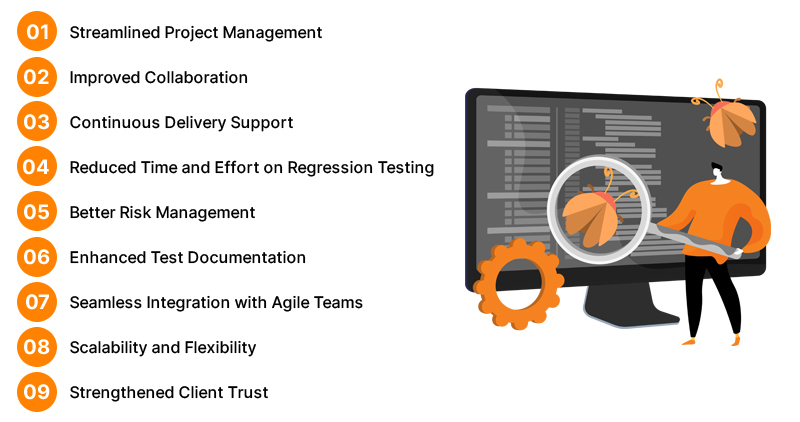Picture this: you’ve got a brilliant software idea and are eager to bring it to life. But the traditional slow and cumbersome testing process puts the brakes on your dreams. That’s when you must embrace Rapid Software Testing, the superhero of software testing methodologies.
Rapid Software Testing is all about delivering top-notch software in the shortest time possible without compromising quality. It’s like having a well-oiled testing machine churning bug-free code at lightning speed. How cool is that?
This guide takes you on a journey through Rapid Software Testing, exploring its benefits, strategies, and best practices. We’ll dive into how it enables early bug detection, seamless collaboration, and increased customer satisfaction.
What is Rapid Software Testing?

Rapid Software Testing (RST) is a modern and iterative approach to software testing that prioritizes speed, efficiency, and the discovery of critical defects. It is designed to quickly provide valuable feedback on software quality, allowing for early bug detection and rapid problem-solving.
In contrast to traditional testing methodologies that follow a predefined and rigid testing plan, RST focuses on exploration, adaptability, and continuous learning. Testers in a rapid software testing environment use their creativity and domain knowledge to design and execute tests, making quick decisions on what and how to test it.
Rapid Software Testing is well-suited for Agile and DevOps development environments, where frequent code changes and shorter release cycles demand a testing approach that keeps up with the development speed. By employing techniques like exploratory testing, test automation, and risk-based testing, RST aims to uncover critical defects early, enabling teams to address issues promptly and deliver high-quality software products accelerated.
The Key Elements of Rapid Software Testing
1. Agile Mindset
Embracing an agile mindset is crucial for rapid testing success. It involves being adaptive, flexible, and responsive to changing requirements and priorities throughout the testing process.
2. Test Automation
Leveraging test automation tools and frameworks is essential to accelerate the testing process. By automating repetitive test cases, the company can achieve faster test execution and increase test coverage.
3. Exploratory Testing
Incorporating exploratory testing techniques allows testers to explore the software creatively, uncovering hidden defects and areas of concern that scripted test cases may not cover.
4. Test Data Management
Efficient test data management is vital to simulate real-world scenarios and validate different use cases. Having a well-organized and diverse set of test data ensures comprehensive testing coverage.
5. Continuous Integration and Continuous Testing
Integrating testing into the CI/CD pipeline enables continuous testing, ensuring that every code change is tested and validated automatically, minimizing delays in the software release process.
6. Collaboration and Communication
Effective collaboration between testers, developers, and stakeholders fosters seamless communication, reducing misunderstandings and ensuring a shared understanding of requirements and expectations.
7. Risk-Based Testing
Prioritizing testing efforts based on risk analysis helps the company allocate resources wisely and focus on critical areas, ensuring that the most vulnerable parts of the software are thoroughly tested.
8. Early Bug Detection
Rapid testing aims to detect and address defects as early as possible in the development cycle, reducing the cost and effort of bug fixes and preventing issues from reaching the production environment.
9. Test Environment Management
Maintaining well-configured and easily accessible test environments enables testers to execute tests promptly and avoid delays caused by setup and configuration issues.
10. Continuous Learning and Improvement
Encouraging a continuous learning and improvement culture empowers testers to stay updated with the latest testing trends, tools, and best practices, enhancing the efficiency and effectiveness of rapid software testing processes.
Benefits of Rapid Software Testing

1. Streamlined Project Management
Rapid Software Testing promotes efficient project management practices, enabling outsourcing companies to streamline testing processes, allocate resources effectively, and meet tight project deadlines.
2. Improved Collaboration
Collaboration between the outsourcing company and its clients is vital for successful software testing projects. Rapid Testing encourages constant interaction, fostering stronger working relationships and ensuring the testing process aligns with client expectations.
3. Continuous Delivery Support
With Rapid Software Testing, outsourcing WA testing services can better support continuous delivery models, where the software undergoes frequent updates and releases. This agility ensures that clients can deploy software enhancements rapidly without compromising quality.
4. Reduced Time and Effort on Regression Testing
By incorporating automated regression testing, outsourcing companies can reduce the time and effort spent on repetitive testing tasks, allowing testers to focus on more exploratory and critical testing activities.
5. Rapid Validation of Quick Fixes
In a fast-paced development environment, Rapid Software Testing empowers outsourcing companies to quickly validate code fixes, ensuring that the software remains stable and functional after updates or bug patches.
6. Better Risk Management
Rapid Testing emphasizes risk-based testing, helping outsourcing services prioritize their efforts on the most critical parts of the software. This proactive approach reduces the likelihood of severe defects escaping to the production environment.
7. Enhanced Test Documentation
While embracing rapid and agile practices, outsourcing companies can still maintain effective test documentation, ensuring that all test cases and results are well-documented for future reference and compliance purposes.
8. Seamless Integration with Agile Teams
Rapid Software Testing complements Agile development methodologies, enabling outsourcing companies to seamlessly integrate their testing efforts with Agile development teams, fostering collaboration and synergy.
9. Scalability and Flexibility
Rapid Software Testing allows outsourcing companies to scale their testing teams up or down rapidly, ensuring optimal resource utilization and responsiveness to client needs as the demand for testing services fluctuates.
10. Strengthened Client Trust
Consistent and reliable results achieved through Rapid Testing build client trust and credibility. The outsourcing company’s ability to deliver top-quality testing services quickly enhances client satisfaction, encouraging long-term partnerships and repeat business opportunities.
Wrapping Up
Incorporating Rapid Software Testing into outsourcing QA testing services brings many advantages, ranging from increased efficiency and adaptability to fostering strong client relationships and business growth. Embracing this approach allows outsourcing companies to excel in the competitive software testing industry while delivering exceptional value to their clients.
You can also hire QA testing experts to ensure top-notch software quality. Their specialized skills and knowledge bring unparalleled benefits, enabling businesses to deliver high-quality products and achieve their development goals swiftly. Embracing this strategy empowers companies to focus on core competencies while leaving their software testing needs to skilled professionals.
Want to ensure your app performs secretly?
Contact Us Today
Summary
Kickstart Your Project With Us!
Popular Posts
CONTACT US
Let's Build Your Agile Team.
Experience Netsmartz for 40 hours - No Cost, No Obligation.
Connect With Us Today!
Please fill out the form or send us an email to







